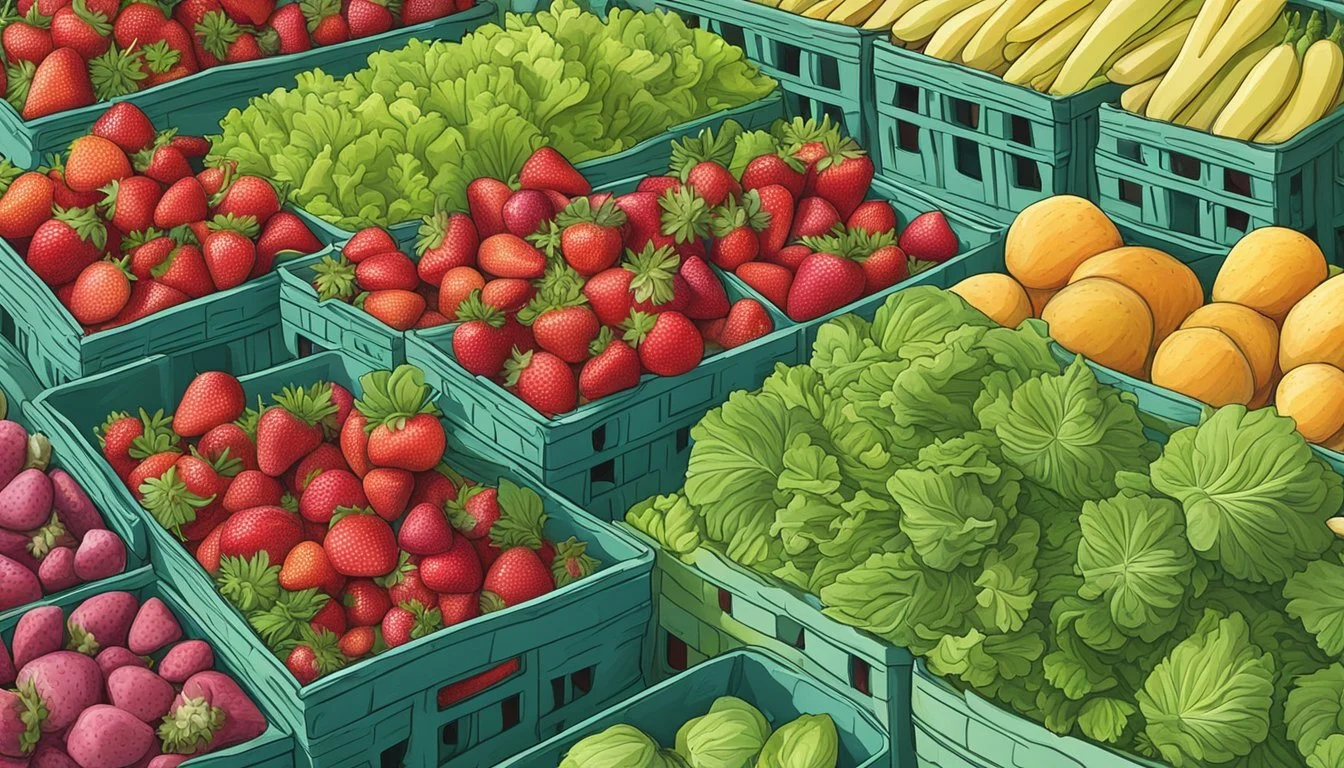Wisconsin Seasonal Fruit & Vegetables in May
Your Fresh Guide
This Article is Part of our Wisconsin Seasonal Fruit & Veg Calendar
Wisconsin thrives with an abundance of fresh produce as spring fully blossoms in May. This period marks a transitional phase for farmers and consumers alike, with local markets beginning to display a more vibrant array of fruits and vegetables. The state, known for its diverse agriculture, offers a variety of seasonal produce that not only supports local economies but also provides the freshest and most nutritious options for healthy eating.
Seasonal fruits are limited in Wisconsin during May, yet the anticipation for the burst of summer berries and orchard fruits grows. Though the last frost dates have passed, many of the fruit varieties are still in the flowering or early growth stages. On the vegetable front, however, May is a time of abundance. Asparagus (What wine goes well with asparagus?), heralding the start of the harvest season, is picked at its peak of flavor and tenderness. Leafy greens like arugula flourish, offering a fresh, peppery addition to spring salads.
Root vegetables that were planted earlier begin to make their way to market stands, with radishes providing a crunchy and spicy component to meals. In addition, greenhouses yield early harvests of herbs and some varieties of tomatoes, presenting opportunities for flavorful culinary creations. While consumers await the arrival of summer's bounty, the produce available in May invites them to enjoy the fresh beginnings that Wisconsin's fields and farms have to offer.
Understanding Seasonality
When discussing seasonal produce, a central theme emerges: the intrinsic link between the produce's peak harvest times and the freshest, most flavorful offerings available. This is particularly true for May in Wisconsin, where both weather and local farming practices dictate the assortment of fruits and vegetables in season.
Seasonal Overview
In Wisconsin, May is a transitional month bridging the cool end of spring and the start of summer. Seasonal produce during this time begins to flourish, providing a variety of fresh options. Given Wisconsin's climate, the month typically introduces a limited but fresh selection that can include the last batches of cool-weather crops like rhubarb and the sprouting beginnings of summer fruits like strawberries.
Spring:
Rhubarb
Early Summer:
Strawberries (Towards the end of May)
Benefits of Seasonal Eating
People who choose to eat what's in season experience multiple benefits:
Nutrient-rich produce: Fruits and vegetables gathered at their peak posses more nutrients.
Flavorful meals: Freshly harvested produce has superior taste.
Support for local farms: Buying seasonal supports Wisconsin's agricultural community.
Wisconsin's Growing Season
The growing season in Wisconsin is markedly distinct due to the state's specific weather patterns. Spring invites the beginnings of warmth, enabling farms to plant and cultivate crops that will mature in the summer. In turn, summer yields a broader spectrum of fruits and vegetables. Farmers carefully track the weather to optimize planting and harvesting schedules, ensuring that fresh, nutrient-dense produce is available for local consumption.
Wisconsin's Farming Calendar:
Planting: Begins in spring as the ground thaws
Harvesting: Varies, with some crops ready in late spring and others in summer
Seasonal Fruits in May
In May, Wisconsin bursts into the fruit season, offering a range of berries and tree fruits. Locally grown produce reaches the shelves of farmers markets, ripe for enjoying fresh or in homemade jams.
Berry Varieties
Wisconsin's berry season begins to take off in May, particularly noted for its strawberries. These vibrant red berries are a staple at local farmers markets and are perfect for a variety of uses from fresh consumption to the creation of delectable jams. Rhubarb, while technically a vegetable, often accompanies strawberries due to its fruit-like applications in desserts.
Strawberries: Available toward the end of May.
Rhubarb: Gains popularity this month and often paired with strawberries.
Tree Fruit Availability
While a bit early for the majority of Wisconsin's tree fruits, there’s an anticipation for the upcoming richness of the summer months. Apples and cherries (how long do cherries last?) are still ripening, but keep an eye out at your local farmers market for early varieties which might make a pre-season debut.
Apples: Late varieties from the previous year may still be available.
Cherries: Not yet in season but highly awaited.
May in Wisconsin is a preview to the luscious fruit bounty that peaks in the summer, with strawberries and rhubarb leading the seasonal surge.
Seasonal Vegetables in May
In Wisconsin, the month of May heralds the arrival of a lush variety of vegetables, with offerings that range from delicate leafy greens to robust root vegetables. Farmers markets begin to brim with the latest harvest, providing fresh ingredients for a plethora of springtime recipes.
Leafy Greens and Herbs
Spinach and Kale: These nutrient-rich leafy greens are at their tender best in May. They are versatile for salads, sautés, and smoothies.
Herbs: Fresh herbs like parsley and cilantro are also plentiful, ready to add flavor to any dish.
Root Vegetables and Tubers
Radishes: Offering a peppery crunch, radishes come into season, perfect for adding a fresh bite to salads.
Potatoes and Onions: While stored from previous harvests, potatoes and onions are still available and are staples for many spring recipes.
Spring Crops
Asparagus: A prized vegetable of spring, asparagus is in full swing, ideal for grilling, roasting, or steaming.
Peas: Sweet peas start to make an appearance, signaling the start of their short but delightful season.
Cabbage: Cabbage continues to be available, ready to be turned into slaws or cooked as an accompaniment to main dishes.
Where to Find Seasonal Produce
In May, Wisconsin offers a variety of venues where consumers can purchase fresh, seasonal produce. Residents have the option to choose between local farmers markets, dedicated grocery stores, and Community Supported Agriculture programs.
Farmers Markets and Stands
Throughout Wisconsin, farmers markets spring to life in May, providing an abundance of locally grown fruits and vegetables. Shoppers can visit farmers market stands to find early seasonal crops and often have the opportunity to directly engage with the farmers. Social media platforms like Facebook and Twitter can be excellent resources for finding locations and operating hours of these markets.
Grocery Stores and Co-ops
Grocery stores and food co-ops are convenient options for a wide range of consumers. They often feature a section for local produce, which supports regional farmers while giving customers access to fresh, in-season fruits and vegetables. These stores are typically easy to find and may also share updates on available seasonal produce via platforms like Pinterest.
Community Supported Agriculture (CSA)
CSA programs in Wisconsin are a direct way for consumers to buy into local farms and receive weekly or bi-weekly shipments of fresh produce. Not only do CSAs ensure a steady supply of seasonal items, but they also foster community engagement and food awareness. Interested individuals can usually find information on joining a CSA by inquiring at local farmers markets or by researching online for nearby farming cooperatives.
Cooking and Storing Tips
In Wisconsin, the month of May offers a bounty of fresh produce that, when handled correctly, can yield delicious meals and extend the enjoyment of seasonal flavors through proper storage.
Preparing Seasonal Produce
One may find asparagus and rhubarb plentiful during May in Wisconsin. Cooking asparagus is straightforward: it can be roasted with olive oil, salt, and pepper to bring out its natural sweetness. Shave raw asparagus into salads for a crisp, tender addition. Rhubarb is often used in recipes for desserts, such as pies and jams. When preparing rhubarb, one should remember to remove the leaves, which are toxic, and to only use the stalks.
Storage and Preservation
Proper storage of seasonal produce ensures longevity and freshness. Asparagus should be kept in the refrigerator, wrapped in a damp cloth or with the ends submerged in water, and it can stay fresh for up to four days. To preserve for a longer period, one can blanch and freeze asparagus spears. Rhubarb also stores well when refrigerated and placed in a plastic bag, lasting for up to two weeks; it can also be cut into chunks and frozen for use in future recipes such as jams or soups.
Impacts on Local Economy and Environment
May in Wisconsin brings a surge in local market activity as seasonal fruits and vegetables become available. This period is critical for both the economy and the ecology of the region.
Support for Local Farmers
Farmers in Wisconsin rely heavily on the sale of fresh produce in local markets during May. This month marks a period where the income for farmers can increase due to the heightened demand for fresh, local produce. Consumers purchasing directly from farmers markets support the local agricultural economy, ensuring that money remains within the community and stimulates local businesses related to farming.
Direct impact on local farms:
Increased revenue from seasonal produce sales.
Enhanced community support for local agriculture.
Environmental Sustainability
Seasonal produce in May, such as asparagus, rhubarb, and various leafy greens, have a lower environmental footprint when compared to non-seasonal or imported produce. The consumption of local vegetables and fruits during their natural growing season reduces the need for long-distance transportation. This, in turn, lessens greenhouse gas emissions contributing to climate change—a critical aspect of maintaining Wisconsin's ecology. Additionally, seasonal farming practices often align with more sustainable agriculture, which can help preserve local ecosystems.
Benefits to the environment:
Reduction in transportation-related emissions.
Support for sustainable farming practices.







